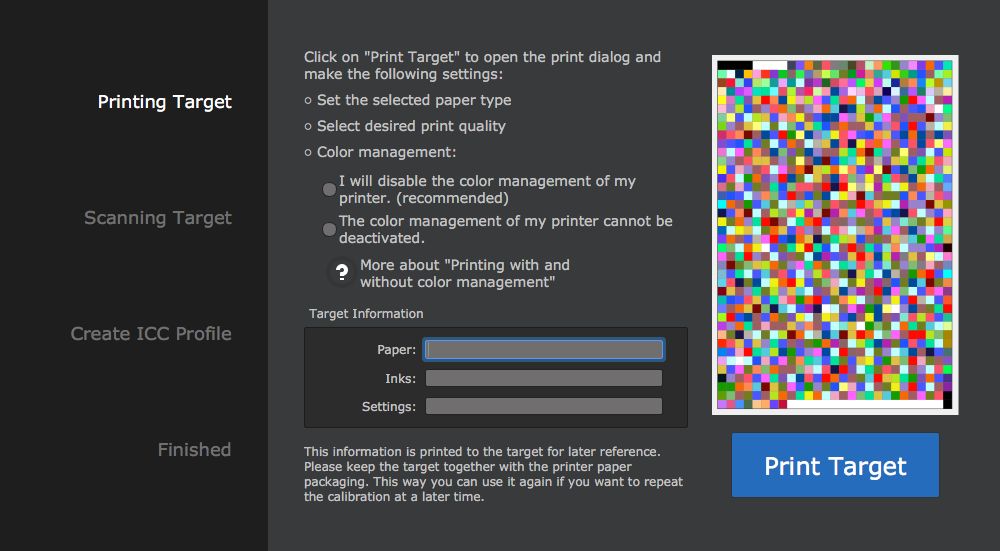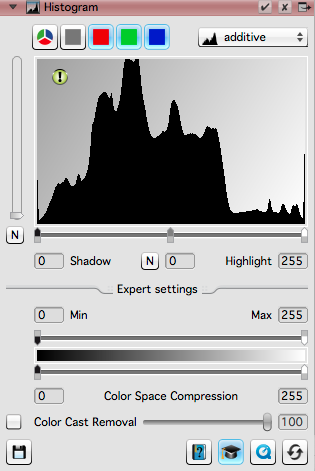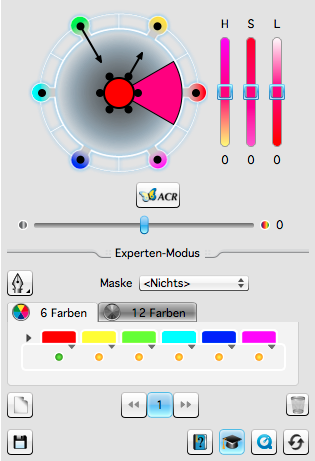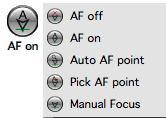 | Unable to shut off color management in printer driver (OS X). |
From OS X 10.6 some printer drivers no longer allow to deactivate the color management. However, this is essential for printing the Printer Calibration target. In SilverFast you can easily chose if your scanner allows this or not. Please check your printer manufacturer's website weather the color management can be deactivated for your printer or not. For some printers a special driver must be installed for this to be possible.
You can select how to print the target here:

For the optimal way of disabling your printer's color management please select the first option:

Information on exactly how to deactivate color management can be found in your printer's manual.
In case disabling the color management is not possible select the second option:

This option will require the following settings:
- open the option Color Matching in the printer settings.
- activate ColorSync.
- select Other Profiles.
- search for Wide Gamut RGB Profile and select it.
- select your paper type, output quality and resolution as usual.
Now you are ready to print a Printer Calibration target and to continue with the calibration process.
|
| | |
|
 | Image information. |
Lists all your settings for your currently active scan-frame. |
| | |
|
 | The Prescan. |
The Prescan obtains a fast scan image from the scanner which allows you to make all your settings.
This is the first step to a scan in SilverFast SE, SEPlus and Ai Studio. |
| | |
|
 | Select Scan mode. |
Available options depend on scanner model:
 reflective reflective for paper and other opaque materials. Only available on flatbed devices.
 transparency transparency for scanning slides and film.
 wide transparency wide transparency for scanning large slides and film. (Available only on certain EPSON scanners.) |
| | |
|
 | The VLT. |
The Virtual Light Table is used to open images for processing in SilverFast HDR (Studio)
It allows you to preview your images prior to opening them. Simply select the images you want to process and drag them onto the JobManager.
To do so mark the images.
Then click on one of them and wait for the mouse to turn into a hand symbol.
Now drag the images onto the JobManager icon.
Holding the Shift-key allows you to use the standard file explorer.
|
|
|
| | |
|
 | Select the image auto adjustment you want to use. |
SilverFast offers various automatic image adjustment methods.
Using them will automatically set the highlights, shadows and gradation to suit your individual image content.
This is an important step and necessary for all images.
|
|
|
| | |
|
 | Select Medium. |
 Positive Positive for scanning slides and reflective media.
 Kodachrome Kodachrome for scanning Kodachrome slides. (only available in transparency mode.)
 Negative Negative for converting negatives into positives using NegaFix. (only available in transparency mode.) |
| | |
|
 | Zoom tool. |
Clicking this button zooms into the active scan-frame or back to the full view.
Holding the command(Mac)/Ctrl(PC) key and left mouse button allows you to drag a box around an area to zoom into. |
| | |
|
 | Histogram adjustments. |
The histogram allows you to manually adjust the highlights, shadows and midtones.
If necessary it also allows you to set the color space compression and adjust the color cast removal strength (CCR).

|
Depending on your version of SilverFast you can select various ways to display the histogram.
The main area of the histogram shows the distribution of the color values throughout the image.
Below it you can drag the markers for the shadows, mid-tones and highlights.
In the expert settings you can select the colorspace compression
and set the color cast removal(CCR) value

more movies
|
|
| | |
|
 | Rotation and flip tool. |
Used for rotating and flipping the entire workplace and.
The tool for the rotation of individual frames on a flatbed is located in the densitometer expert settings. |
| | |
|
 | Creating and changing scan frames. |
The Frame menu allows you to access all tools used for creating, saving, loading, copying and deleting frames.
which tools are available depend on your version of SilverFast.
It allows you to automatically create frames using the automatic find frames option.
On devices which can handle several frames (like flatbed devices) it allows you to easily copy settings to all frames from the selected frame to all others.
In SilverFast Ai Studio it further allows you to save and load settings for a frame and even use them as default for all frames you create.
This for example includes the resolution and the settings for all active tools. |
| | |
|
 | Gradation adjustment. |
The gradation allows you to individually adjust the brightness values.
The Midtone slider allows you to make your image appear brighter without "burning out" any colors. Which is why the slider has certain limits.
In addition you can adjust the contrast values.
|
|
|
| | |
|
 | Pipette tool. |
The pipette tool allows you to manually select the highlights and shadows in your image and remove color casts.
To remove a color cast simply open the pipette tool and select the neutral point pipette.
Now click on the an area in your image which should be a neutral grey.
SilverFast will use this information to remove the color cast.
SilverFast Ai Studio allows to set up to 4 neutral points for an even more precise correction.
Using the 4 point pipette in Ai Studio:
|

|
Using the single point pipette:
|

more movies
|
|
| | |
|
 | Un-Sharpening Mask (USM) |
The USM tool allows you to sharpen your images.
To view your changes in the preview window please activate the 1:1 preview in the USM dialog.
|
|
|
| | |
|
 | How do I select the image auto adjustment for a batch scan. |
|
The image auto adjustment type can be selected in the preferences' Auto tab.
|
|
|
| | |
|
 | iSRD infrared scratch and dust removal. |
iSRD is a fully automatic scratch and dust removal tool. It detects defects through the hardware using the scanners infrared sensor.
This option is only available for transparency scans and scanners which offer an infrared channel.
It can not be used with silver halide based B&W film. The silver halide emulsion of these films block the infrared beam (more info here).
|
|
|
| | |
|
 | How can I measure the maximum usable resolution for my scanner? |
The edge contrast defines the actual resolution an individual device can obtain.
This value varies from the given physical resolution due to several physical effects.
This knowledge allows you to select the most efficient resolution for your scans.
Obtaining the best resolution and sharpness while limiting scan time.
LaserSoft Imaging offers the USAF resolution target to measure this resolution.
It allows you to measure your scanner's best resolution and to set the optimal USM values for a certain resolution.
More information on the USAF can be found here on our website.
These targets can also be purchased in our onlineshop.
For more information please visit our movie page.
Here you will find our movies on setting the resolution for your SilverFast product.
|
| | |
|
 | How to adjust individual colours. |
The Selective Color Correction (Selective CC) allows you to select individual color values and adjust them.

For greyscale mode this tool is replaced by the Selective Color to Grey (SC2G) tool.
|
Simply click on the center circle and the pick a color from your image.
Now you can edit the colour value by dragging the small black circles or by changing the HSL(Hue, Saturation, Luminescence) values.
The Expert mode allows you to limit the changes by adding a mask.
You change between 6 colour and 12 colour editing mode.
And use presets for the individual color channels.
In SilverFast Ai Studio you can use up to four individual layers for masks with individual settings.
|
| |
| | |
|
 | SRDx scratch and dust removal. |
SRDx is the new advanced software sided scratch and dust removal. It is especially suited for correcting B&W and high-density Kodachrome film. To view the changes you have to activate the 1:1 or HQ preview in the SRDx tool dialog.
The Ai Studio and HDR Studio expert dialog offers the possibility to use up to four masks to limit the correction to certain areas. Each mask can have different settings to allow precise corrections. The new brush and eraser tools also allow for a much more easier handling and a quick correction of your images.
SRDx is included in all SilverFast versions since version 8.8 and replaces SRD. Masking, brush and eraser functions are only available in Ai Studio and HDR Studio.
|
|
|
| | |
|
 | Auto Adaptive Contrast Optimization. (AACO) |
AACO enhances specific contrast levels.
By individually adjusting it's settings to a specific image you can enhance the visibility of certain areas.
|
|
|
| | |
|
 | SRD scratch and dust removal. |
SRD is the software sided scratch and dust removal. Other than the hardware based iSRD this tool must be adjusted individually to each image. To view our changes you have to activate the 1:1 preview in the SRD tool dialog.
The expert dialog offers the possibility to use masks to limit the correction to certain areas. SilverFast Ai Studio offers up to four layers with different settings.
SRD has been replaced by the more advanced SRDx in version 8.8
|
|
|
| | |
|
 | Scan / Process |
This is the final step.
After pre-scanning/loading and setting up your image it starts the final scan (SilverFast SE, SE Plus and Ai Studio) or processing ( SilverFast HDR and HDR Studio) of the image.
It also allows you to switch between batch and single mode.
|
|
|
| | |
|
 | Sharing on the web. |
|
You can directly upload your scanned/processed images on Flickr,Facebook or Dropbox.
|
|
|
| | |
|
 | Grain and Noise Elimination. (GANE) |
GANE allows you to remove the film grain and sensor noise from a scan.
Many current scanners are able to scan at resolutions which are higher than the film resolution.
In such cases the film structure (grain) becomes visible.
The noise is a natural effect occurring in the scanner sensor.
SilverFast's Multi-Exposure (available in SilverFast SE Plus and Ai Studio)can prevent this from occurring.
|
|
|
| | |
|
 | Descreening. |
Removes print screen from reflective material.
This tool is only available for flatbed devices in reflective mode.
In case this tool does not work as expected, please check the entered screen value.
|
|
|
| | |
|
 | Multi-Exposure. (ME) |
Multi-Exposure uses two separate scans to achieve a much higher Dynamic-Range than a standard scan could.
This greatly reduces sensor noise. Especially in dark image areas. Additionally the higher Dynamic-Range offers a great advantage when processing images in professional imaging software like SilverFast HDR Studio or Photoshop.
Multi-Exposure is available in SilverFast SE Plus and Ai Studio.
|
|
|
| | |
|
 | Focus tool |
The focus tool is only available if the scanner offers a focus function.
Which options are available also depends on the functions your scanner offers.
Scanners with a fix-focus unit do not offer this tool.

Manual Focus Control
Please refer to our movie and PDF manual to learn how to use the manual focus control.
|
|
|
| | |
|
 | IT8 calibration. |
The IT8 calibration creates an individual ICC profile for your scanner. It makes sure your scanner produces correct colours and utilises the entire range of colours available from it's sensor.
This is a basic step in professional image processing.
The SilverFast IT8 calibration is fully automatic. In most cases no user interaction is required. Only the target's reference file might have to be provided. The profile is automatically created and put in use.
The IT8 calibration is available in SilverFast Ai Studio.
|
|
|
| | |
|
 | Can I adjust my calibrated printer profile? |
Yes you can. The Printer Calibration Profile Editor allows you to adjust your calibrated profiles to your workflow.
Since color is a subjective perception, SilverFast offers the option of editing the generated profile according to the user’s desires.
|
|
|
| | |
|
 | JobManager. |
The JobManager allows you to set up jobs containing several images.
You can define the order in which the images are scanned (for auto numbering).
You can copy selected settings and combine them individual settings for individual images.
It allows you to either copy manual settings or the auto adjustment you would like to use.
The automatic image adjustment (e.g. auto CCR) will then be individually executed for each image.
The JobManager is available in SilverFast Ai Studio and HDR (Studio).
|
|
|
| | |
|
 | PrinTao. |
SilverFast Ai/HDR Studio offers the integrated PrinTao printing interface for directly printing your scans.
It is includes in SilverFast Ai Studio and HDR Studio.
Please do not confuse this option with our new and advanced PrinTao 8 Software.
|
|
|
| | |
|
 | Overview |
This tool is only available for Scanners with automated filmstrip or slide magazine processing.
It allows you to get an overview of the filmstrip and select (blue) which images to scan.
An offset correction tool is also available to correct the position of individual images.
This is only available if the software supports offset correction.
Users of slide magazine scanners can set up the magazine position and amount of slides.
Scanners with dual scan mode (single slide and film strip) only show this option if a film strip is inserted.
|
|
|
| | |
|
 | How do I create multi-page PDFs with SilverFast? |
The standard PDF output creates a single page PDF.
On flatbed devices you can use the print function or PrinTao to create a multi-page PDF.
On single frame and feeder scanners multi-page PDFs are only available through external tools. |
| | |
|
 | I can not select negative or Kodachrome modes. |
Make sure transparency mode is selected.
In cas that is not possible follow the above link (headline). |
| | |
|
 | I can not select transparency mode. |
The transparency selection(s) do not appear when I click the reflective button.
I can not select Negative and Kodachrome modes. |
| | |
 Usage Questions
Usage Questions English
English Deutsch
Deutsch Français
Français Italiano
Italiano 日本語
日本語 Español
Español Português
Português Russian
Russian Chinese (Simp.)
Chinese (Simp.) Czech
Czech Polish (Store only)
Polish (Store only)







 reflective for paper and other opaque materials. Only available on flatbed devices.
reflective for paper and other opaque materials. Only available on flatbed devices.



 Kodachrome for scanning Kodachrome slides. (only available in transparency mode.)
Kodachrome for scanning Kodachrome slides. (only available in transparency mode.) Negative for converting negatives into positives using NegaFix. (only available in transparency mode.)
Negative for converting negatives into positives using NegaFix. (only available in transparency mode.)



























